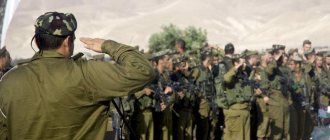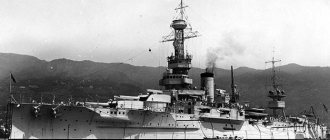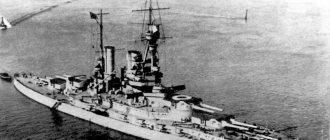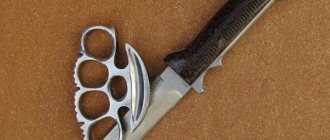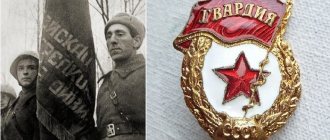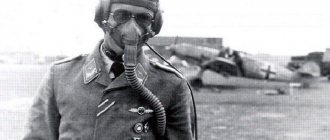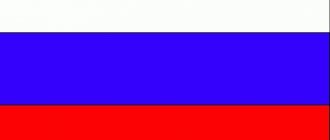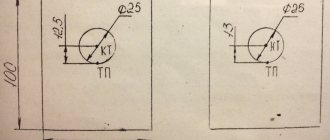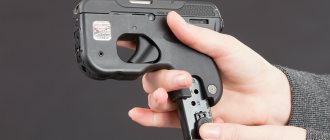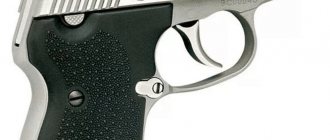Since the times of the Soviet Union, the Airborne Forces (Airborne Forces) have been considered the army elite. Serving in the “winged infantry” has always been considered honorable, and in society, belonging to it is associated with courage, determination, courage, and excellent physical fitness. Airborne Forces lapel badges are one of the attributes indicating membership in the airborne assault force.
The lapel symbols are made of metal. On them are two airplanes with an open parachute canopy between them, and a star in the center. The sign has special antennae for attaching to the form. There are also ceremonial buttonholes - they are golden in color. Paratroopers wear them on the occasion of demobilization, formations, parades and other celebrations.
Paratrooper 1931
In the USSR, they tried in every possible way to emphasize the special status of the airborne assault force, which is why they separated it into a separate branch of the military. The Airborne Forces have a recognizable uniform, symbols, and motto. Over the years of its existence, the military brotherhood has formed its own traditions.
The first insignia of paratroopers appeared at about the same time as the Airborne Forces - February 12, 1931. It was the “Parachutist” sign, established by decision of the Central Council of OSOAVIAKHIM. But a month later, the head of the Red Army Air Force allowed it to be used as an incentive for personnel for successful training parachute jumps.
The badge was awarded to military personnel who completed one familiarization or forced jump from an airplane. The photo shows that this Airborne Forces badge is made in the shape of a quadrangle with a golden edging. In the 1931 samples, the lower corner of the quadrangle was sharp, which caused the badge to cling to clothing and partially chip off the enamel. In 1936, this deficiency was corrected by blunting the corner.
The entire surface of the badge is covered with dark blue enamel. Inside there is an open parachute with eight lines. Below is a figurine of a parachutist. At the top there is a red five-pointed star and the hammer and sickle emblem on it.
On the reverse side there is a serial number and a pin for attaching to clothing. At first it was attached above the left pocket, but since 1943 it has been worn on the right side, to the left or below other state awards.
Currently, the following varieties of the 1931 model “Parachutist” are known:
- The first 100 signs are made of silver in a Leningrad workshop. According to one version, the owner of honorary badge No. 1 was the military pilot Minov, who was the first in the USSR to make a training jump. It was July 26, 1930 in Voronezh.
- There is little information about the silver batch, but the production of bronze accessories with nuts and a mark is definitely confirmed. They were designed by Leningrad jeweler Georgy Svenson, and produced by the All-Russian Union “Vsekohudozhnik” in Moscow.
- Another version of the badge was issued for military personnel of the Red Army. On it the figure of a parachutist is straight and elongated. The serial number on the reverse consisted of 3, 4 or 5 characters. There were no letters in front of the numbers.
- The fourth type of sign is with a flat reverse, a serial number of 4 or 5 characters and a curved figure.
- There is another option with a counter-relief reverse, elongated lower rays of the star and a parachutist figurine that looks more like a leaf.
For what merits were awards given?
Badges and special medals reflect the entire range of achievements of a serviceman, although their significance cannot be compared with military government awards. As a rule, the first special sign that adorned the chest of an airborne paratrooper was the parachutist badge, awarded after the first parachute jump. Its design has changed several times since the 1930s, but this particular sign is one of the indispensable attributes of belonging to the Airborne Forces.
Later variations of this badge were the “Excellent Parachutist” and “Parachutist Instructor”, originally issued for 8 and 50 jumps, respectively. Over time, the number of required jumps changed to 10 and 100, and similar badges established by the Ministry of Defense for paratroopers were supplemented with overhead replaceable numbers displaying dozens or hundreds of jumps completed.
A number of badges and medals are awarded for certain successes in service in the ranks of the Airborne Forces. Commemorative medals of the airborne troops, which have the status of “departmental awards,” as well as memorial signs and medals established by authoritative public (primarily veteran) organizations, have become widespread.
For service
In Soviet times, privates and sergeants of the airborne troops did not have special badges other than paratrooper badges. Since the 1940s, soldiers have been awarded insignia in their military specialty (“Excellent machine gunner,” “Excellent signalman,” etc.), and a soldier could have several such badges. Since 1957, they have been abolished, replaced by a single badge “Excellence in the Soviet Army” and similar badges for the Air Force and Navy.
For airborne paratroopers, a similar award was established as an “all-army” excellence badge, although many holders replaced them with “aviation” ones. But this was done unofficially, already during demobilization.
Russian badge "Excellent Airborne Forces"
The special badge “Excellence in the Airborne Forces” appeared already in the 2000s, but never became official, approved by order of the Ministry of Defense. It was issued in several varieties, based on the average emblem of the troops and the lapel badge of the Airborne Forces, and was not used for wearing by the troops, but was used only during significant military parades.
At various times, the Ministry of Defense of the Russian Federation approved a number of departmental awards for service achievements for the command staff of the Airborne Forces.
| Name of the award | Year of establishment | Status Features |
| Medal “Participant of the forced march June 12, 1999 Bosnia - Kosovo” | 2000 | Participation in the operation to transfer a combined battalion of the Russian Airborne Forces from the international peacekeeping contingent to the city of Pristina. |
| Badge of Merit | 2005 | Service life in the Airborne Forces is over 5 years, exemplary performance indicators. |
| Badge "For Distinction" | 2005 | Service life in the Airborne Forces over 1 year, successful completion of special tasks. |
| Medal "Army General Margelov" | 2005 | Service life in the Airborne Forces is over 15 years (for veterans - 25 years), presence of the “For Merit” badge. |
| Insignia "For service in military intelligence of the Airborne Forces" | 2014 | The status has not been officially made public; awards to veterans and “supporting persons” are allowed. |
Medal "Veteran of the Airborne Forces": front and back sides
For Airborne Veterans
In addition to a number of the above departmental insignia, special awards to veterans of the airborne troops have a public status. The most honorable of them is the “Veteran of the Airborne Forces” medal, established by the Council of Veterans of the Russian Airborne Forces. In addition to Russian citizens who served in the Airborne Forces, this medal is also awarded to former military personnel of the airmobile forces of the CIS countries.
Among other veteran public organizations, it should be noted as the most authoritative Union of Russian Paratroopers, uniting veterans of not only the Airborne Forces, but also the Marine Corps and GRU Special Forces. Among the awards of this organization, the Order of Army General Margelov (as well as the medal of this order) and the Medal “For Military Valor” have the highest status. A large number of awards are commemorative medals dedicated to participation in military operations, including:
- "Combat Veteran";
- “Veteran of local wars of the USSR and Russia”;
- “Veteran of military operations in the Caucasus”;
- “Participant in hostilities in the North Caucasus. 1994 - 2004";
- “For service in the North Caucasus”;
- “For participation in counter-terrorism operations in the Caucasus”;
- “Participant in hostilities in the North Caucasus. 15 years";
- “15 years of the withdrawal of Soviet troops from the DRA”;
- “20 years of the withdrawal of Soviet troops from the DRA.”
Among the veteran awards given to activists of military-patriotic education, the medals “Veteran of the Airborne Forces of Russia”, “For Loyalty to the Airborne Brotherhood”, “Airborne Forces of Russia. Nobody except us".
75 years of Airborne Forces
Among the non-state memorial signs dedicated to the airborne troops, the medal “75 Years of the Airborne Forces” became very famous. This is due to the rather large-scale official celebration of the anniversary and, as a consequence, to a wide range of recipients of this medal. Of particular interest is the reverse side of this award, which bears the inscription “Commanders of the Airborne Forces” followed by the names and initials of all military leaders who held this post from 1930 to 2005.
A set of anniversary medals for the 85th anniversary of the Airborne Forces from one of the manufacturers
85 years of Airborne Forces
More than a dozen varieties of non-state anniversary award badges dedicated to the 85th anniversary of the Airborne Forces were issued in Russia. The most common award was issued by the Union of Paratroopers of Russia, but other public and veteran organizations also ordered the anniversary medal under virtually the same name. In addition, several types of awards in the form of orders, as well as two- and three-level award signs in the form of crosses, were made for the anniversary.
Parachutist 1936
The Airborne Forces badge of the 1936 model differs from the previous one in its smaller size, blunt lower corner and lack of a number on the reverse side.
Accessories were produced by several companies:
- Leningrad Enamel Factory - on its samples all parts are nickel-plated, light blue and dark blue enamel are used as the background;
- The Moscow Pobeda factory also used dark and light enamels; its products are recognizable by their bronze outlines;
- The Moscow Mint produced items with a horizontal pin and a screw fastening. On the reverse side there is a stamp “MMD”.
These signs were awarded until November 1955, and then they were replaced by the attributes of a new type. In the history of the Airborne Forces, there are cases when paratroopers attached metal “Parachutes” to homemade pads. The pads were made of metal in the shape of an airplane or wings, and pendants were attached to them. The number of suspensions was equal to the number of parachute jumps.
Where is it used?
The coat of arms of the Russian Airborne Forces can be seen everywhere on August 2. Even in the smallest cities of our homeland or in the town, former and current paratroopers celebrate their holiday. The Airborne Forces flag is hung in all specialized military units not only on the occasion of their own holiday, but also during official Russian events it is officially raised on the flagpole. During mourning events, for example, in memory of fallen paratroopers, the flag is lowered.
Nowadays it is also fashionable to decorate private houses with various symbols. Therefore, successful retired paratroopers often use the flag or coat of arms of the Airborne Forces as a decoration for their home in memory of their past service. They put it on a flagpole on the roof or hang it by the front door. Symbols can also decorate the central gate.
Airborne Forces emblem
For almost 25 years, the “winged infantry” did not have special emblems. The first insignia appeared in 1946 - it was a sleeve patch. The situation changed dramatically when in 1954 Vasily Margelov was appointed commander of the Airborne Forces.
Under his command, the airborne assault force became one of the most mobile and combat-ready units. The modernization of troops also affected the uniform of military personnel. In 1955, the famous Airborne Forces emblem appeared. It shows a parachute with two planes taking off on either side.
This emblem soon became the logo, . On its basis, all breastplates and souvenir badges and other symbols of the elite military unit were subsequently developed.
A parachute surrounded by two planes became a symbol of the spiritual unity of the paratroopers, familiar not only to the military, but also to civilians. The author of the idea and sketch is Zinaida Bocharova, who worked in the 60s as a leading draftsman at the headquarters of the Airborne Forces.
The history of the creation of the sketch began with the command announcing a competition for the best emblem. Vasily Margelov succinctly formulated the requirements for it: simple, understandable, without heraldic fabrications and frills, but so that anyone can see and understand that in front of him is a paratrooper.
Thousands of letters with sketches arrived at the Airborne Forces headquarters - they were sent by authors from different parts of the Soviet Union. But the commission headed by Margelov recognized the drawing by Zinaida Bocharova as the best.
The commander, summing up the results of the competition, told the officers that they walk past the draftsman every day and see nothing. But she loves the troops with all her heart, that’s why her emblem has the airborne spirit, even though she herself has never jumped with a parachute.
In 1978, Vasily Filippovich retired, but before he left the headquarters, he looked into the drawing office to once again thank Zinaida Bocharova. Then he said that her emblem would outlive them both and thanked all the airborne troops.
Margelov’s words turned out to be prophetic, because the famous parachute with airplanes, as before, adorns the uniform of Russian Airborne Forces, badges, flags, emblems and stripes.
On souvenir badges and other products, this symbol is always in the center, and civilians, without further ado, determine its identity.
The main differences between badges and medals
The concept of “breast insignia” combines a variety of badges, as well as medals and orders. Their differences among themselves are not always manifested in the external form or type of attachment to clothing. The main principle of distinction is the status of such signs: decorative or actually confirmed by an award. In other words, the badge can serve as a meaningless decoration, but the medal must indicate a certain merit of its owner.
In recent decades, the award paraphernalia of the Airborne Forces has become not only an integral element of clothing at memorable and festive events for those who actually served in the ranks of the “winged infantry”. Fame, public recognition and the elite status of the Airborne Forces made such paraphernalia a popular collectible, which led to a wide range of offers from souvenir manufacturers.
In fact, badges previously belonged to the category of souvenirs. Their main difference from badges (in relation to the Airborne Forces) is their status: if anyone can purchase an “airborne” badge, the insignia was issued for certain actions, and the fact of awarding such badges, even if they were called “badges” , was accompanied by a certain set of supporting documentation: orders, certificates, etc.
A special situation arose with medals. Unlike the times of the USSR, when the concept of “medal” meant the obligatory state or departmental affiliation of this type of award, in the Russian Federation almost any public organization has the right to award medals. At the same time, the fact of being awarded a public medal still contains some moral incentive, albeit without any benefits and privileges accorded to holders of state and departmental awards.
Veteran paratroopers with anniversary awards
Therefore, the abundance and variety of public awards related to the Airborne Forces generally benefits society, allowing us to additionally pay tribute to veteran paratroopers and note the role and significance of these troops in the history of the country and its Armed Forces. Evidence of the continued attention to this is the appearance of several anniversary public awards dedicated to the 90th anniversary of the Airborne Forces in 2020.
Other signs
Since 2005, Russian airborne units have expanded the line of symbols - small, medium and large emblems developed according to the laws of heraldry appeared.
A small emblem of gold color, made like a grenade with angel wings. Wings are associated with high maneuverability and willingness to sacrifice oneself, and Grenada indicates good training of army personnel.
The middle one is decorated with a double-headed eagle with a crown. On the chest of the bird is the Moscow coat of arms with the image of St. George the Victorious. In its paws the eagle holds a silver sword and a winged grenade. The sword is an ancient symbol that demonstrates readiness to immediately engage in battle.
The large emblem is made in the form of a round blue shield and combines elements of the small and medium ones. In the center of the circle is a golden grenada with spread wings. The blue shield is framed by a wreath of oak branches, personifying strength and courage, strength and indestructibility. At the top is a coat of arms in the form of a double-headed eagle with a sword in its hand.
All three variants of images are often used when designing souvenir and commemorative chest accessories.
History of the flag
The flag has the same symbolic meaning as the coat of arms of the Airborne Forces. It depicts a golden skydiver with an open parachute. Two planes are visible on its sides. This logo appeared before the official emblem, in 2004. The flag is divided into two unequal parts. The top 2/3 of the flag is occupied by a large blue stripe. It symbolizes the sky. It is in this part that the paratrooper with the planes is located. The second part of the flag is green. It symbolizes the pure land. The entire flag is made in quite bright colors, which means a peaceful sky and land, which the Airborne Forces soldiers are called upon to protect.
"Nobody except us"
Another element of the chest symbol is the phrase “Nobody but us.” It became the motto of the air brotherhood with the light hand of General Vasily Margelov.
“Brothers! No one but us can complete this difficult task!” - he addressed the paratroopers on the eve of large-scale exercises. And the next day the Krasnaya Zvezda newspaper published an article with the headline “Nobody but us.” So the phrase became the motto of an elite army unit.
How symbolism is used
The flag of the Russian Airborne Forces, the symbols of this military institution and various paraphernalia are now in the public domain. Anyone can purchase it at Voentorg. Therefore, not a single August 2nd passes without car processions, from the windows of which Airborne Forces flags peek out, fluttering in the wind. On this day, blue berets often adorn the heads of all paratroopers and even those people who are only indirectly related to the flying troops.
The coat of arms of the Airborne Forces in the vector is freely available. Therefore, it is not surprising that with the arrival of the holiday, and more and more often, people related to the airborne troops put stickers with symbols on their cars. It could be a flag, a coat of arms, or just a picture with an inscription. For example, a parachute and the slogan “Nobody but us,” which we’ll talk about a little later. It is difficult to say whether such a manifestation of one’s devotion is necessary, but in any case, to some extent it develops patriotism towards Russia as a whole.
Interesting Facts
- Today, the Russian Airborne Forces remain the most numerous in Europe.
- During World War II, paratroopers had to jump while aboard airborne combat vehicles.
- The paratroopers' vests differ from the sailors' uniforms in the color of the stripes. For Airborne Forces soldiers they are blue.
- Blue berets only became part of the uniform in 1969. Before this they had a bright crimson color.
- One of the legends about why paratroopers bathe in fountains says: a real Airborne Forces soldier simply adores the sky. When he sees the reflection of his native element in the fountain, he wants to plunge into the clouds, even if they are reflected.
- In 2022, the Airborne Forces celebrated its holiday - the elite troops are already 87 years old.
